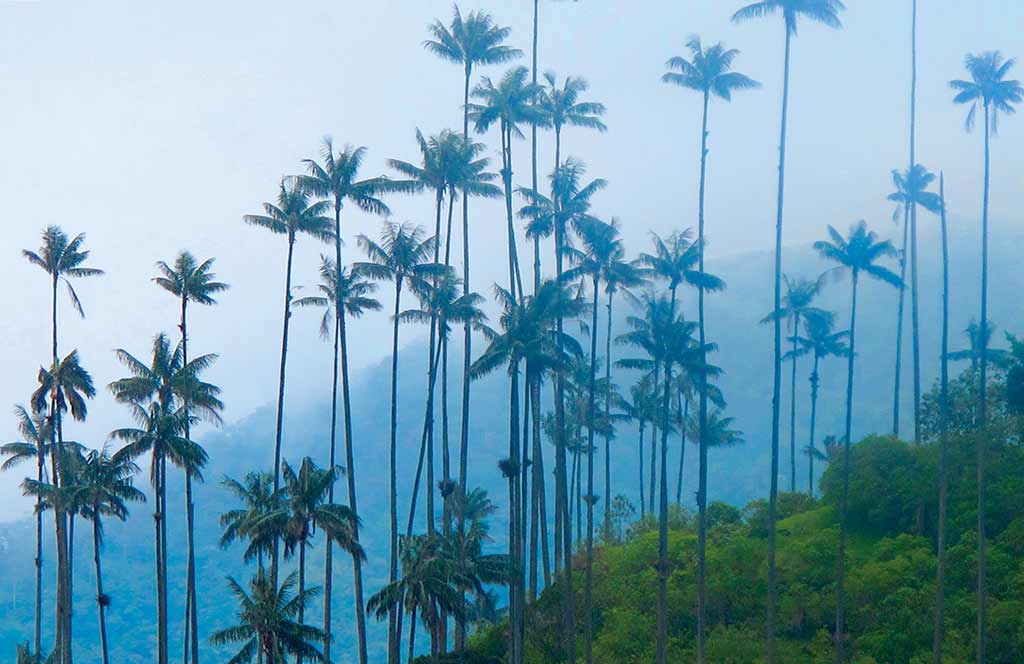The main attraction for most visitors to Salento is seeing the palmas de cera (wax palms) that shoot up towards the sky in the Valle de Cocora. These are some of the tallest palms in the world, reaching 50-60 meters high (200 feet), and they can live over 100 years. They have beautiful, smooth, cylindrical trunks with dark rings. In 1985, they were declared to be the national tree of Colombia.
If you opt for the longer hike, that same spectacular scenery comes at the end of a walk that saves the valley of the palms for last, like a delicious dessert.The Valle de Cocora is a 15-kilometer (9-mile) section of the lower Río Quindío valley. Much of it has been turned into pastureland, but, thankfully, the palms have been preserved. The palms look particularly stunning in the denuded pastureland.
The picturesque Valle de Cocora and its famous wax palms. Photo © Andrew Dier.
The gateway to the valley is the Vereda de Cocora, a stretch of restaurants specializing in trout. This vereda (settlement) is a major domestic tourist destination and can get incredibly crowded during holidays and weekends. Most Colombian tourists come for a late lunch and take a stroll along the main road behind the vereda to view the palms. However, there are two much more rewarding excursions: a leisurely 90-minute walk to La Montaña, a ranger station for the local environmental agency, or a more intense five-hour loop through the valley and up the Río Quindío and back via La Montaña.
For the La Montaña hike, continue down the main road beyond the Vereda de Cocoa and pass through the gate of a private farm on the right where a signpost reads “FCA. EL BOSQUE 7.6 KM.” Follow a path that meanders six kilometers (four miles) up hills converted to pastureland and then along a ridge on one side of the Valle de Cocora to the ranger station. The views from the path onto the wax palms in the valley and mountainside are stunning. If you opt for the longer hike, that same spectacular scenery comes at the end of a walk that saves the valley of the palms for last, like a delicious dessert.
For the longer hike, take a right through a gate painted blue after the last building in the Vereda de Cocora. After walking about four kilometers (2.5 miles) through pasture, you’ll enter the dense forest. The path crisscrosses the trickling Río Quindío. After three kilometers (two miles) you reach the Reserva Acaime (cell tel. 321/636-2818 or 320/788-1981, COP$4,000), a private reserve created to preserve the surrounding cloud forest. With the entrance fee, you can enjoy a complimentary cup of hot chocolate, agua de panela (a hot sugary drink), or coffee and watch throngs of hummingbirds of several varieties fly up to feeders. It’s quite a show. You can also stay at Acaime, either in private rooms or a large dormitory (COP$40,000 pp including all meals).
From Reserva Acaime, you backtrack a kilometer and then climb a steep path to La Montaña. The last leg of the hike, back from La Montaña to Vereda del Cocora, provides the best and most memorable photo opportunities of the valley and hundreds upon hundreds of wax palms. Make sure your camera batteries are charged, as you’ll want to take many pictures. The entire loop takes 4-5 hours. You may want to wear rubber or waterproof boots, as the path along the Río Quindío is muddy. There is no need for a guide.
To get to Vereda del Cocora from Salento, take a Jeep Willy (COP$3,500), which leave the Plaza Pincipal at 6am, 7:30am, 9:30am, and 11:30am each day.
Excerpted from the First Edition of Moon Colombia.